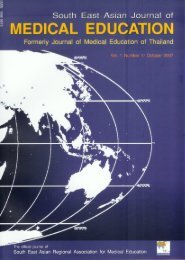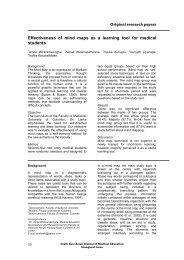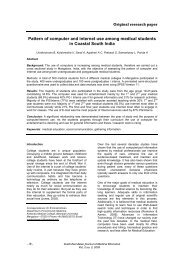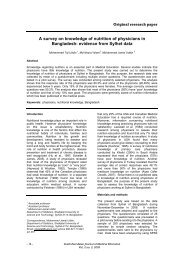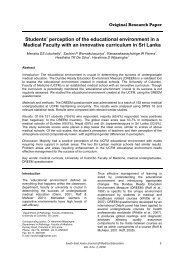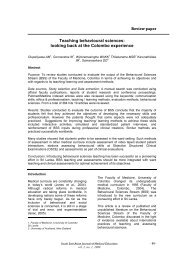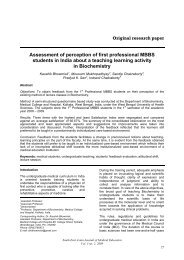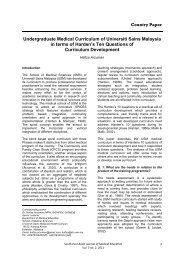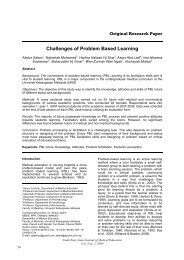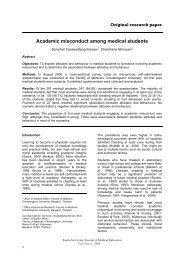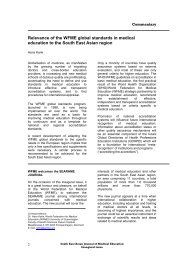Integrating evidence - based medicine in bedside teaching: a pilot ...
Integrating evidence - based medicine in bedside teaching: a pilot ...
Integrating evidence - based medicine in bedside teaching: a pilot ...
You also want an ePaper? Increase the reach of your titles
YUMPU automatically turns print PDFs into web optimized ePapers that Google loves.
the undergraduate student (Azarpazhooh<br />
et al., 2008).<br />
Teach<strong>in</strong>g at the <strong>bedside</strong> is thought to be<br />
applicable to any situation where the<br />
teach<strong>in</strong>g occurs <strong>in</strong> the presence of the<br />
patient (Jenk<strong>in</strong>s et al., 2007; Yusuf, 2005).<br />
Moreover, this method of teach<strong>in</strong>g has a<br />
potential to improve EBM practice and<br />
subsequently, the quality of care for<br />
patients. This study, thus aims to explore<br />
the understand<strong>in</strong>g and attitudes of<br />
undergraduate students towards the EBM<br />
<strong>in</strong>tegrated <strong>bedside</strong> teach<strong>in</strong>g.<br />
Material and Methods<br />
Study design<br />
This is a before-after comparison <strong>pilot</strong><br />
study to explore the attitudes of<br />
undergraduate medical students towards<br />
EBM before and after EBM <strong>in</strong>tegrated<br />
<strong>bedside</strong> teach<strong>in</strong>g.<br />
Participants<br />
Twenty four of 5 th year medical students<br />
rotated <strong>in</strong> Paediatric department, Khon<br />
Kaen Hospital dur<strong>in</strong>g November-<br />
December 2006 were recruited.<br />
Procedure<br />
The selected students were allocated<br />
equally <strong>in</strong>to 4 groups. EBM <strong>in</strong>tegrated<br />
<strong>bedside</strong> teach<strong>in</strong>g was conducted <strong>in</strong> 4<br />
sessions which lasted approximately 1-1.5<br />
hours for each. The pr<strong>in</strong>ciples of practice<br />
of EBM were taught and asked the<br />
students were requested to put them to<br />
practice at each session.<br />
Intervention<br />
At each session, one of four pr<strong>in</strong>ciples of<br />
EBM practice was taught, the concept of<br />
each pr<strong>in</strong>ciple be<strong>in</strong>g <strong>in</strong>troduced<br />
didactically at the beg<strong>in</strong>n<strong>in</strong>g of the<br />
session. Students were then encouraged<br />
to do group practice immediately<br />
afterward. All of the steps were performed<br />
regard<strong>in</strong>g patients’ problems that arose<br />
dur<strong>in</strong>g the <strong>bedside</strong> teach<strong>in</strong>g <strong>in</strong> each<br />
session. The four steps (pr<strong>in</strong>ciples) of<br />
EBM <strong>in</strong>cluded:<br />
(i) Formulate an answerable question<br />
(ii) Track down the best <strong>evidence</strong><br />
(iii) Critically appraise the <strong>evidence</strong><br />
(iv) Integrate with cl<strong>in</strong>ical expertise and<br />
patient values<br />
Ma<strong>in</strong> outcome measures and<br />
questionnaire adm<strong>in</strong>istered<br />
Newly developed and <strong>pilot</strong>ed semistructured<br />
questionnaires were distributed<br />
and students were asked to fill <strong>in</strong> the<br />
questionnaire before and then after the<br />
conclusion of 4 sessions.<br />
The questionnaire covered the follow<strong>in</strong>g<br />
areas<br />
1. Resources where student used to<br />
access EBM<br />
2. Confidence of us<strong>in</strong>g accessed<br />
<strong>in</strong>formation<br />
3. Attitudes of EBM <strong>in</strong>tegrated <strong>bedside</strong><br />
teach<strong>in</strong>g <strong>in</strong>clud<strong>in</strong>g satisfaction<br />
4. Conflicts arisen from EBM practic<strong>in</strong>g<br />
5. Idea about EBM <strong>in</strong>tegrated <strong>bedside</strong><br />
teach<strong>in</strong>g<br />
Moreover, a group of 6 medical students<br />
who reported that EBM was not necessary<br />
to medical students were asked to enroll <strong>in</strong><br />
the focus group discussion to confer their<br />
attitude about practic<strong>in</strong>g EBM. A time and<br />
venue comfortable to the students was<br />
arranged. Broad questions about EBM<br />
practice were <strong>in</strong>itially discussed. Students<br />
were encouraged to talk openly and<br />
<strong>in</strong>formally along with appropriate probes to<br />
encourage participant elaboration and<br />
clarification. Projective question<strong>in</strong>g<br />
procedures will be used to tap emotional<br />
responses. All the discussions were taped<br />
recorded and then transcribed. A brief<br />
presentation was fed back to the group for<br />
verification of data given by them.<br />
The group discussion lasted approximately<br />
1 hour, and all were moderated by an<br />
<strong>in</strong>vestigator. The students were<br />
encouraged to have a genu<strong>in</strong>e discussion,<br />
talk<strong>in</strong>g between themselves rather than<br />
address<strong>in</strong>g all their remarks to the<br />
moderator. However, steps were taken to<br />
create an atmosphere of mutual trust and<br />
respect. This ensured that <strong>in</strong>dividuals<br />
stayed with<strong>in</strong> the whole-group discussion,<br />
that the moderator can <strong>in</strong>tervene to probe<br />
and move the discussion on when<br />
necessary, and that <strong>in</strong>terruptions and<br />
<strong>in</strong>stances of more than one person talk<strong>in</strong>g<br />
at a time were kept to a m<strong>in</strong>imum.<br />
Pilot<strong>in</strong>g of the questionnaire<br />
The <strong>pilot</strong> study was conducted with up to<br />
20 <strong>in</strong>terns to check for the completeness<br />
of the questionnaire. This took approximately<br />
- 56 -<br />
South East Asian Journal of Medical Education<br />
vol. 2, no. 1, 2008




